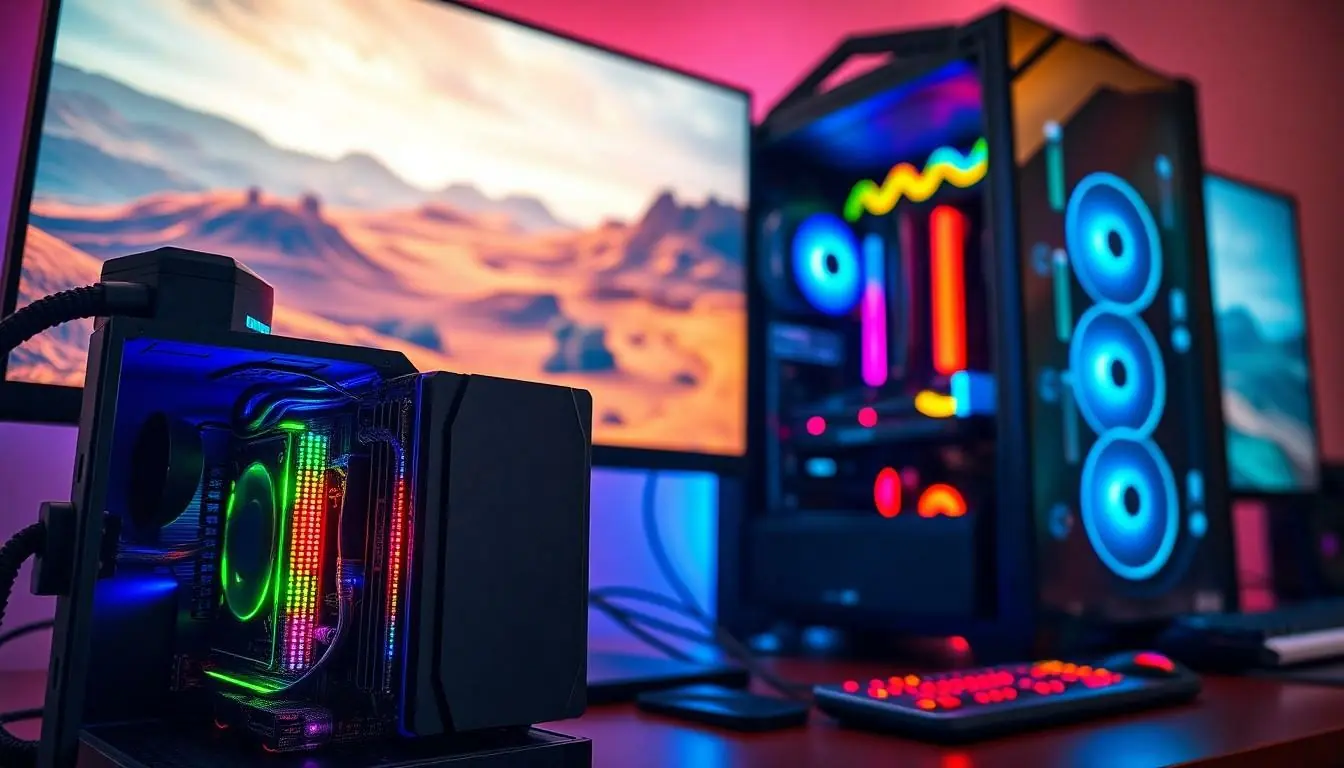Table of Contents
ToggleWhen diving into the chaotic world of Rust, gamers often find themselves pondering a crucial question: is this survival masterpiece powered more by the CPU or the GPU? It’s a bit like trying to figure out if a hot dog is a sandwich—both sides have their passionate supporters, and the debate can get spicy.
Overview of Rust
Rust is a multiplayer survival game developed by Facepunch Studios. Players navigate a hostile environment, gather resources, and build shelters to survive against threats. With a blend of crafting, exploration, and combat, it emphasizes player interactions in a dynamic world.
Game mechanics heavily depend on server performance. Optimal server-side processing requires significant CPU resources, especially with multiple players present. As player counts increase, CPU demands also rise, impacting overall gameplay experiences.
On the visual side, Rust employs advanced graphics and intricate environments. High-quality textures and detailed landscapes enhance immersion. This graphical fidelity leans on GPU capabilities, influencing frame rates and rendering quality.
Various factors affect performance in Rust. For instance, the game’s large open-world design requires both server and client systems to perform well. Keeping a balance between CPU and GPU usage directly influences overall gameplay smoothness.
Optimizing settings can improve performance metrics. Gamers often adjust graphical settings to achieve desirable frame rates. Lowering graphics can result in higher FPS, making CPU performance more apparent during intense gameplay scenarios. The choice between better visuals or smoother gameplay becomes critical.
Understanding whether Rust is more CPU or GPU intensive remains complex. It relies on multiple elements, including player count, server load, and graphical settings. Each gamer may experience different performance based on personal hardware configurations and preferences.
Understanding CPU and GPU
CPUs and GPUs play crucial roles in gaming performance, particularly in a game like Rust. Knowing their functions helps clarify performance expectations.
What Is a CPU?
A CPU, or central processing unit, serves as the brain of a computer. It executes instructions from programs, handles calculations, and manages data flow. Rust demands considerable CPU resources, especially during increased player interactions. Complex game mechanics rely on a strong CPU for tasks like managing server performance and processing player actions. Gamers often seek high clock speeds and multiple cores to enhance performance in resource-intensive scenarios. Consequently, an effective CPU directly impacts the overall gameplay experience.
What Is a GPU?
A GPU, or graphics processing unit, specializes in rendering images and videos. This component takes charge of graphics calculations, significantly enhancing visual quality. Rust features elaborate graphics that benefit from a powerful GPU for seamless rendering of environments. Many gamers prioritize GPUs with higher frame rates, ensuring smoother gameplay. Visual effects, shadows, and textures require substantial GPU power to maintain quality. Therefore, an efficient GPU is vital for enjoying Rust’s intricate landscapes while balancing performance and visuals.
Performance Analysis of Rust
Rust’s performance demands a careful balance between CPU and GPU capabilities. Understanding these requirements provides insight into optimizing gameplay.
CPU Requirements for Rust
Rust’s gameplay places heavy demands on CPU resources. Processing multiple player interactions in real-time significantly affects server performance. As player counts increase, CPUs must efficiently manage complex tasks like calculating physics and AI behaviors. A multi-core processor often enhances performance, allowing for better multitasking. Players with stronger CPUs experience fewer lags and improved responsiveness. Game updates and frequent patches also require substantial CPU power for effective integration. Players benefit from investing in higher-end processors to fully experience Rust’s dynamic environments.
GPU Requirements for Rust
Graphics in Rust rely heavily on GPU capabilities. Vibrant landscapes and intricate textures require powerful GPUs for smooth rendering. Frame rates and graphical details largely determine the visual experience. Lower-end GPUs often struggle with maintaining optimal performance, especially in dense player areas. Further, visual effects like lighting and shadows enhance immersion but demand additional GPU resources. Gamers tend to prioritize higher quality settings, which can impact frame rates. Investing in a capable GPU ensures a smoother and more visually appealing experience in Rust.
Optimizing Rust for Hardware
Optimizing Rust for hardware performance requires fine-tuning settings to ensure a smooth gameplay experience. Players can enhance both CPU and GPU performance through specific adjustments.
Settings for Better CPU Performance
Adjusting the game’s server settings can improve CPU performance. Reducing the maximum allowable players per server helps decrease the load on the CPU, enhancing responsiveness. Disabling unnecessary background processes can also free up CPU resources, allowing for better processing of game mechanics. Furthermore, increasing the priority of Rust in the task manager ensures it receives more CPU time. Regularly updating drivers and optimizing the operating system helps maintain overall performance. Allocating additional cores for Rust in the CPU settings can significantly enhance its performance, especially in crowded scenarios.
Settings for Better GPU Performance
Enhancing GPU performance involves tweaking graphical settings. Lowering the resolution and texture quality can increase frame rates, especially in dense environments. Reducing shadow quality and disabling anti-aliasing can relieve the GPU, creating a smoother visual experience. Adjusting the field of view allows for a broader perspective without overloading the GPU. Utilizing a performance mode in graphics settings prioritizes frame rate over visual fidelity. Players should keep their GPU drivers updated, as manufacturers often release optimizations for specific games. Ensuring that V-Sync is disabled frees the GPU to maximize frame output, enhancing overall gameplay fluidity.
Conclusion
Determining whether Rust is a CPU or GPU game isn’t straightforward. The game demands a robust CPU for managing player interactions and server performance while also requiring a powerful GPU for rendering its stunning graphics. Players need to strike a balance between both components to enjoy an optimal gaming experience.
Investing in capable hardware can significantly enhance gameplay, especially in densely populated areas. By understanding the specific needs of Rust, gamers can tailor their setups for improved performance, ensuring a smoother and more immersive experience in this dynamic survival world.











